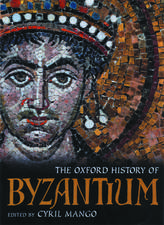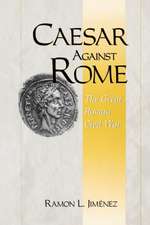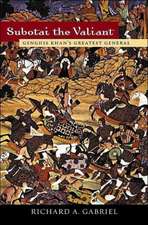Sport in Ancient Times: Praeger Series on the Ancient World
Autor Nigel B. Crowtheren Limba Engleză Hardback – 29 ian 2007 – vârsta până la 17 ani
| Toate formatele și edițiile | Preț | Express |
|---|---|---|
| Paperback (1) | 175.04 lei 3-5 săpt. | |
| University of Oklahoma Press – 31 dec 2009 | 175.04 lei 3-5 săpt. | |
| Hardback (1) | 505.27 lei 6-8 săpt. | |
| Bloomsbury Publishing – 29 ian 2007 | 505.27 lei 6-8 săpt. |
Preț: 505.27 lei
Nou
Puncte Express: 758
Preț estimativ în valută:
96.68€ • 100.75$ • 80.05£
96.68€ • 100.75$ • 80.05£
Carte tipărită la comandă
Livrare economică 03-17 aprilie
Preluare comenzi: 021 569.72.76
Specificații
ISBN-13: 9780275987398
ISBN-10: 0275987396
Pagini: 208
Dimensiuni: 156 x 235 x 21 mm
Greutate: 0.48 kg
Editura: Bloomsbury Publishing
Colecția Praeger
Seria Praeger Series on the Ancient World
Locul publicării:New York, United States
ISBN-10: 0275987396
Pagini: 208
Dimensiuni: 156 x 235 x 21 mm
Greutate: 0.48 kg
Editura: Bloomsbury Publishing
Colecția Praeger
Seria Praeger Series on the Ancient World
Locul publicării:New York, United States
Notă biografică
Nigel B. Crowther is Professor of Classical Studies at the University of Western Ontario.
Recenzii
Crowther provides here the second volume in the Praeger Series on the Ancient World, which is aimed at the nonspecialist and general reader. Crowther's broad sweep includes the role of sports in ancient Egypt and the Middle East, early China and Japan, and even Mesoamerica. He focuses on Greek athletics (especially the Olympics) and Roman contests (especially spectator sports) and their use for political purposes, and he expands his discussion to sport in the Byzantine Empire, particularly charioteering. Other chapters emphasize social issues, and include a comparison of noted Greek, Roman, and Byzantine athletes and a discussion of the changing role of women in sport. Crowther's main themes include amateurism and professionalism, fair play, crowd behavior, politics, class, and sexuality. He includes a time line and a brief annotated list of further readings, but no notes. Crowther seems current with relevant sources, so one regrets his failure to name the authorities he discusses. Excellent graphics. Recommended. Lower-/upper-division undergraduates; general readers.
This book lays the foundation for studying sport within any number of disciplines, exploring the games and competitions of ancient society around the world in order to arrive at an understanding of the forms sports take today..[W]hat distinguishes Sport in Ancient Times from a rich, growing body of literature examining the heritage of sport is that Crowther also explores the role of women and the place of sport in China, Japan, and the Middle East, areas heretofore given short consideration in sports historiography.. By presenting evidence for sports in nearly every part of the world, he provides substance for contemporary research. The writing is clear and concise, and the solid bibliography includes easily accessible books. Sport in Ancient Times is appropriate for librarians from secondary through college levels, and, in fact, is so illuminating that it should be required opening text for any college course that deals with sports.
Crowther provides a historical overview of sport as a cultural practice around the world from about 3000 BCE to the Middle Ages, mentioning nonphysical recreations and games occasionally but concentrating on activities that embrace contests, skill, training, energy, and fitness. The survey, organized by geography, discusses such topics as early forms of polo and golf in China, sumo wrestling in Japan, bull leaping and boxing in Crete, Homeric descriptions of Ancient Greek sport, Roman gladiatorial combats and chariot racing, and team ball games in Mesoamerica, among many others. The range of themes that arise is similarly broad and includes such issues as bribery, cheating, ideals, amateurism and professionalism, violence, ritual, social class, tourism, and war. Distributed in the US by the U. of Washington Press.
Although [Crowther] does not shy away from difficult concepts and technical terms, he writes clearly and without excessive 'dumbing down.' Realizing, however, that even college-educated readers are liable to be a little hazy about the dates of Chinese and Egyptian dynasties and the periodization of Green and Roman antiquity, he includes a helpful set of 'timelines' (xiv-20).
This book lays the foundation for studying sport within any number of disciplines, exploring the games and competitions of ancient society around the world in order to arrive at an understanding of the forms sports take today..[W]hat distinguishes Sport in Ancient Times from a rich, growing body of literature examining the heritage of sport is that Crowther also explores the role of women and the place of sport in China, Japan, and the Middle East, areas heretofore given short consideration in sports historiography.. By presenting evidence for sports in nearly every part of the world, he provides substance for contemporary research. The writing is clear and concise, and the solid bibliography includes easily accessible books. Sport in Ancient Times is appropriate for librarians from secondary through college levels, and, in fact, is so illuminating that it should be required opening text for any college course that deals with sports.
Crowther provides a historical overview of sport as a cultural practice around the world from about 3000 BCE to the Middle Ages, mentioning nonphysical recreations and games occasionally but concentrating on activities that embrace contests, skill, training, energy, and fitness. The survey, organized by geography, discusses such topics as early forms of polo and golf in China, sumo wrestling in Japan, bull leaping and boxing in Crete, Homeric descriptions of Ancient Greek sport, Roman gladiatorial combats and chariot racing, and team ball games in Mesoamerica, among many others. The range of themes that arise is similarly broad and includes such issues as bribery, cheating, ideals, amateurism and professionalism, violence, ritual, social class, tourism, and war. Distributed in the US by the U. of Washington Press.
Although [Crowther] does not shy away from difficult concepts and technical terms, he writes clearly and without excessive 'dumbing down.' Realizing, however, that even college-educated readers are liable to be a little hazy about the dates of Chinese and Egyptian dynasties and the periodization of Green and Roman antiquity, he includes a helpful set of 'timelines' (xiv-20).




















